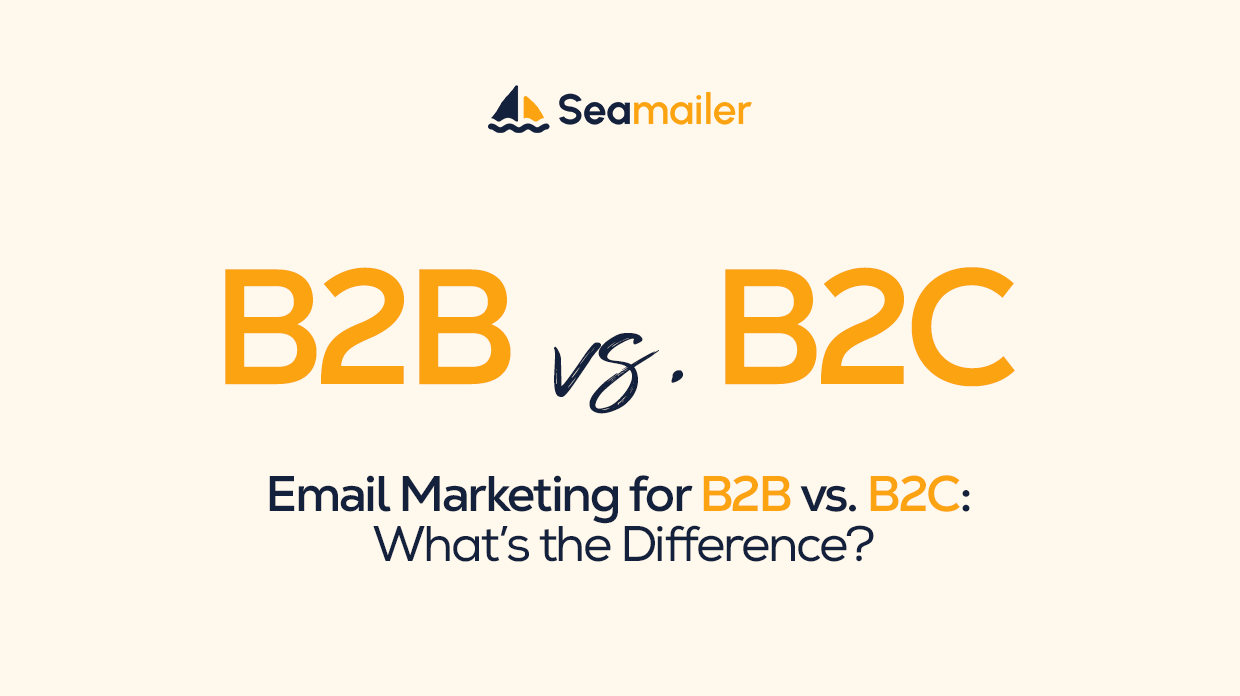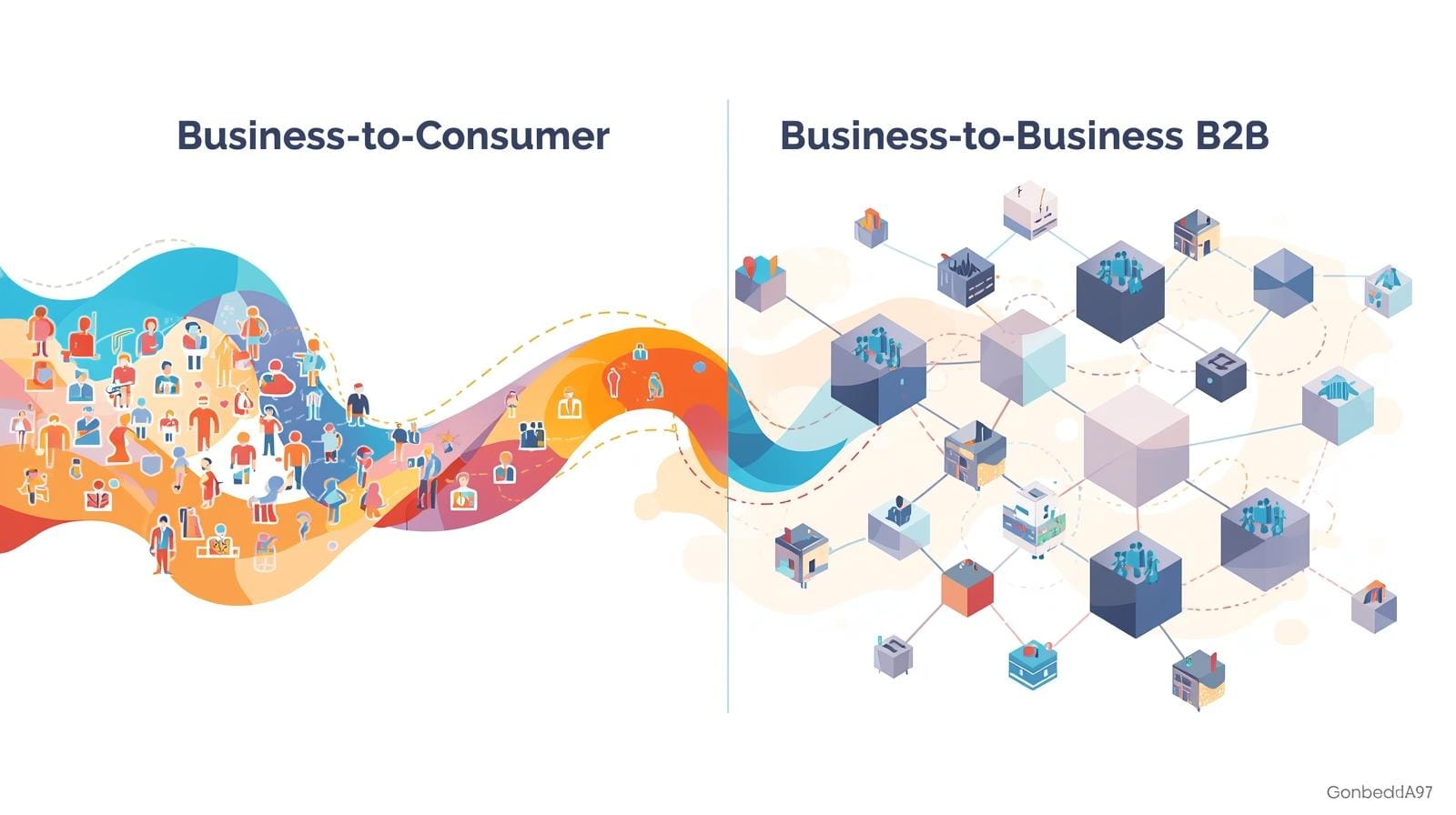Email Marketing for B2B vs. B2C: What’s the Difference?

After two decades of staring at open rates, subject lines, and click-through metrics, I have seen it all. I have watched email marketing evolve from a digital version of direct mail to a sophisticated, hyper-personalized conversation. It’s a craft, and like any good craftsperson, you learn to see the subtle differences that make all the difference.
Today, let's talk about the grand canyon of email marketing: the one that separates B2B from B2C. You see, on the surface, they look like two sides of the same coin. Both are about sending a message to a list. Both use a subject line and a body. Both have a call to action.
But scratch beneath that surface, and you’ll find two fundamentally different worlds. To treat them the same is like trying to convince a farmer to buy a sports car—it's fast and shiny, but it doesn't solve his problem.
So, pull up a chair. Let's get real about what truly separates the business-to-business inbox from the business-to-consumer one.
1. The Audience: The Boardroom vs. The Living Room
This is the most crucial distinction, the very heartbeat of your entire strategy. In B2C, you are speaking to an individual. You are trying to tap into their emotions, desires, and immediate needs. You are a storyteller, an entertainer, a friend who just discovered a fantastic deal.
Think about it. When you get an email from your favorite clothing brand, what makes you open it? Is it a detailed report on the fabric’s durability and cost-per-wear ROI? Or is it a subject line like, "Your new favorite sweater is 50% off!"? It’s emotion. It's the promise of looking good, feeling comfortable, or simply getting a great deal.
Now, shift your perspective. In B2B, you are not emailing just one person; you are emailing a representative of a company. You are not appealing to their personal desire for a new gadget. You are appealing to their professional need to solve a business problem. Their decisions are based on logic, data, and a clear return on investment (ROI). They are asking: "How will this save us money, increase our efficiency, or drive revenue?"
The person on the other end is a buyer, a manager, or a CEO with a whole team of stakeholders to please. The emotional appeal is secondary; the logical, data-driven argument is paramount.

2. The Content: Educational Value vs. Emotional Appeal
This is where the audience difference really starts to show.
In the B2C world, your content needs to be quick, visually appealing, and emotionally resonant. Think:
- Flash Sales: "24 Hours Only! Get 70% Off." Urgency and scarcity are powerful tools.
- Lifestyle Imagery: A picture of a family laughing on a beach, selling you not just a product but a feeling.
- User-Generated Content: Reviews and photos from real customers build trust and create a sense of community.
- Product Spotlights: A quick, punchy email showing off a new arrival with a clear call to action (CTA).
The goal is to move them from browsing to buying in a matter of seconds. You are the friendly shopkeeper, showcasing your best wares in a beautifully lit window.
For B2B, that approach will land you squarely in the spam folder. Your audience doesn't have time for fluff. They want substance. Your content is about establishing yourself as a thought leader, a trusted partner, and a genuine problem-solver. Your content toolbox should include:
- Case Studies: "How Company X Increased Revenue by 30% with Our Solution." This is your bread and butter—proof that you deliver.
- Whitepapers and E-books: In-depth, educational content that tackles a specific industry challenge. You're not just selling a product; you’re providing expertise.
- Webinar Invitations: "Join our webinar on 'Scaling Operations in 2026' with industry leaders." This offers value and a chance for direct, professional engagement.
- Industry Reports: Data-backed insights that help decision-makers stay ahead of the curve.
Your tone should be professional, authoritative, and focused. You are a consultant, not a hawker.
3. The Sales Cycle: The Sprint vs. The Marathon
The buying journey is the final piece of this puzzle, and it's where B2B and B2C diverge completely.
B2C is a sprint. A customer sees an email, clicks a link, and buys a pair of shoes. The entire process, from first touch to final conversion, can happen in minutes. Their purchasing journey is often a straight line, influenced by impulse and a quick emotional hit.
This means your email sequences can be short and focused: a welcome email, a series of promotional offers, and maybe an abandoned cart reminder. You are looking for a quick sale.
B2B is a marathon. A single purchase can take months, sometimes even over a year. Why? Because it’s not one person making the decision. It’s a procurement team, an IT department, a finance manager, and the C-suite. Your email has to nurture a relationship through a complex, multi-layered approval process.
Your email strategy, therefore, must be a long-term nurturing sequence. This is where a platform like Seamailer truly shines. Seamailer isn't just about sending emails; it's about building a journey. Its advanced automation tools allow you to create intricate, multi-step email workflows. You can send a case study to a prospect, and if they click a specific link, Seamailer can automatically trigger a follow-up email with a demo invitation. If they don't engage, it can send a different email, perhaps a blog post, to keep them in the loop.
This kind of intelligent automation is critical. A B2B campaign isn't about one-and-done emails. It’s a thoughtful sequence designed to build trust and demonstrate value over time.
4. The Metrics: The Who vs. The What
While both measure open rates and click-through rates, the why behind those metrics is different.
For B2C, a high open rate on a promotional email means your subject line was catchy, and a high click-through rate means your offer was enticing. Success is often measured in direct sales and revenue per email. It's about immediate, tangible results.
For B2B, the metrics tell a story about engagement and readiness. A high open rate might signal that your whitepaper topic is a pain point for your audience. A click-through to a case study shows they are evaluating your solution. A webinar registration tells you they are seriously considering a purchase. Success is measured in qualified leads, sales pipeline growth, and the slow, steady conversion of a cold prospect into a paying client.
Platforms like Seamailer provide robust analytics that go beyond simple opens and clicks. They let you track user behavior within your emails, see what content resonates, and identify which prospects are hot, warm, or cold. This data-driven insight is the compass that guides your B2B marathon.
A Final Thought
In my years of experience, the most fascinating part of this journey has been seeing the lines blur. The most successful B2B marketers today are borrowing from the B2C playbook. They are realizing that even a CEO is a human being. They are not just selling to a company; they are connecting with a person who has their own inbox, their own morning coffee, and their own set of anxieties about their job.
So, the beautiful twist is this: While the core strategies for B2B and B2C are different, the ultimate goal is the same. It's about genuine connection. For B2C, that connection is built on a flash of emotion and desire. For B2B, it's a slow burn of trust, credibility, and providing real, quantifiable value.
Whether you are selling a new pair of sneakers or a complex SaaS solution, you’re still talking to a person. Your job is to understand their world, respect their time, and deliver a message that doesn't just ask for a sale, but offers a solution—or a smile.
It’s the great inbox divide, but with the right tools and a clear strategy, you can master both sides and win the race. And in my experience, the platforms that understand this human element—like the intelligent automations and deep analytics offered by a tool like Seamailer—are the ones that will keep you ahead of the curve, year after year.

